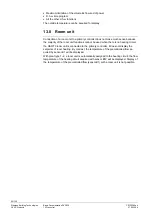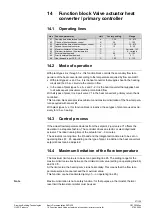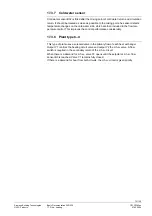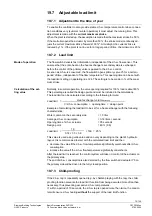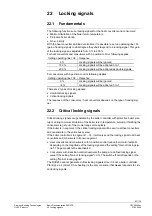
70/130
Siemens Building Technologies
Basic Documentation RVD230
CE1P2383en
HVAC Products
17 D.h.w. heating
27.05.2004
pump operate during the defined pump overrun times; the storage tank charging pump
by an adjustable period of time (operating lines107 and 108).
However, both the charging process and pump overrun can be stopped by the protec-
tion against discharging.
These choices are supported by plant types x–10, 2–7 and 6–7.
17.2.4 Feeding the circulating water into the heat exchanger
It is possible to configure the feeding of circulating water into the heat exchanger (oper-
ating line 54). The following settings are available:
Setting Circulating
pump
Feeding the circulating
water into…
Function, action
0 No
–
No
control
1
Yes
the storage tank
No control, no compensation of
heat losses
2
Yes
heat exchanger
80 % of the heat losses will be
compensated
3
Yes
heat exchanger
Full compensation of heat losses;
constantly aiming for the d.h.w.
flow temperature setpoint
Setting 2:
A flow temperature drop of 20 % is accepted. The behavior is the same as that with
d.h.w. heating directly via heat exchanger (setting on operating line 54 = 2). When a
d.h.w. charging cycle is completed, the circulation will first be charged for 5 minutes
before the demand for d.h.w. becomes invalid.
17.3 Direct d.h.w. heating
17.3.1 General
Direct d.h.w. heating via heat exchanger is covered by plant types x–4. . .
17.3.2 D.h.w.
heating
D.h.w. heating takes place directly via heat exchanger, which can have a flow switch
fitted on the secondary side. With plant type 8–4, the flow switch is mandatory. Use of a
circulating pump is optional. The relevant settings are to be made on operating lines 54
and 55.
The actuating device is always 2-port valve Y5 in the primary return of the d.h.w. heat
exchanger; it is controlled according to temperature B3 in the secondary flow of the
heat exchanger.
To ensure good control performance, a fast actuator with a running time of 10…35
seconds is required; its opening and closing times may be different.
For operating lines, settings and additional explanations, refer to chapter 19 “Function
block Valve actuator d.h.w.”
17.3.3 Protection
against cooling down
Protection against cooling down is available with plant types featuring direct d.h.w.
heating (x–4 and x–8). It is used to prevent the primary side of the d.h.w. heat ex-
changer from cooling down. There is a risk of cooling down (leading to long waiting
times when d.h.w. is needed) when, during longer periods of time,
General

